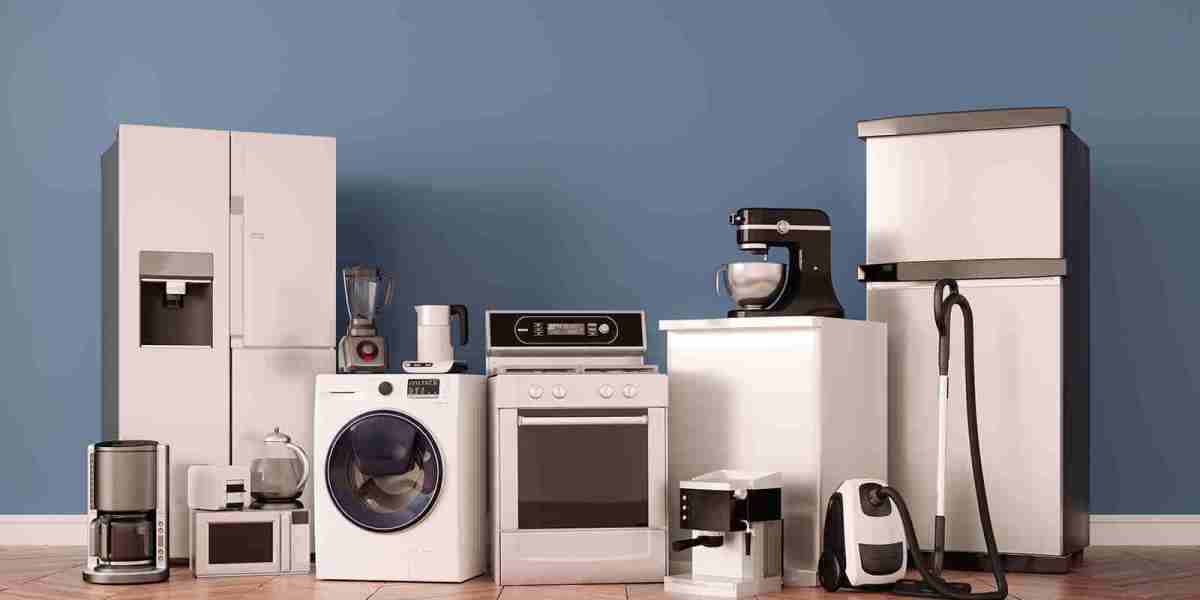Introduction
The white goods market, encompassing household appliances such as refrigerators, washing machines, dishwashers, and air conditioners, is undergoing a significant transformation driven by sustainability and the growing demand for eco-friendly solutions. As consumers become more environmentally conscious, they are increasingly prioritizing energy-efficient, eco-friendly, and sustainably produced products. This shift is not just a response to regulatory pressures but also a reflection of a broader societal trend toward sustainability.
This article explores how the white goods industry is embracing sustainability through eco-friendly solutions, focusing on technological innovations, material sourcing, energy efficiency, and recycling efforts.
1. Energy Efficiency and Reduced Carbon Footprint
a. Energy-Efficient Appliances
Energy efficiency is one of the most critical components of sustainability in the white goods market. As energy consumption remains a primary concern for consumers, manufacturers are focusing on producing appliances that use less power while maintaining optimal performance.
Inverter Technology: Appliances such as air conditioners, refrigerators, and washing machines are increasingly equipped with inverter technology, which adjusts the motor speed based on the appliance's load and usage. This reduces power consumption, enhances the appliance’s lifespan, and cuts down on energy waste.
Energy Star Ratings: Many consumers now actively seek appliances that come with Energy Star certifications or other energy efficiency ratings. These appliances are designed to meet strict guidelines for energy consumption, helping consumers save on utility bills while contributing to lower carbon emissions.
Smart Energy Management: The advent of smart home technologies allows consumers to control and monitor the energy usage of their white goods. Smart appliances equipped with Wi-Fi connectivity enable users to track energy consumption in real-time and optimize their usage based on patterns. This promotes responsible energy use, reduces waste, and improves overall energy efficiency.
2. Eco-Friendly Refrigerants and Cooling Systems
a. Sustainable Refrigerants
Refrigerators, freezers, and air conditioners traditionally relied on refrigerants like hydrochlorofluorocarbons (HCFCs) and chlorofluorocarbons (CFCs), which are harmful to the environment and contribute to ozone depletion and global warming. However, manufacturers are increasingly shifting toward more sustainable alternatives.
Hydrofluoroolefins (HFOs): Newer refrigerants like HFO-1234yf are being adopted due to their lower global warming potential (GWP) and zero ozone depletion potential. These environmentally friendly alternatives reduce the impact of white goods on climate change.
Natural Refrigerants: Some companies are turning to natural refrigerants such as propane (R-290) and carbon dioxide (CO2), which have minimal environmental impact. These refrigerants have low GWP and are often non-toxic and non-flammable, making them safer and more sustainable alternatives to traditional refrigerants.
b. Improved Insulation Materials
The use of better insulation materials in refrigerators and freezers has also been a significant move toward sustainability. Manufacturers are now using materials like cyclopentane, a hydrocarbon foam, which is not only energy-efficient but also ozone-friendly. These innovations help maintain internal temperatures with less energy, leading to reduced energy consumption and carbon emissions.
3. Sustainable Material Sourcing
a. Recyclable and Renewable Materials
Manufacturers are increasingly adopting recyclable and renewable materials in the construction of white goods. This reduces the overall environmental impact of these products and encourages a circular economy where materials are reused rather than disposed of.
Recycled Plastics: Many white goods manufacturers are moving toward using recycled plastics in the production of appliances. This reduces the demand for virgin plastic and minimizes waste, especially from discarded appliances.
Sustainable Metals: The use of metals such as aluminum and steel, which are infinitely recyclable, is becoming more common. These metals are used in the construction of washing machine drums, refrigerator bodies, and other key components. By recycling these materials, manufacturers can reduce energy consumption and minimize the environmental footprint of raw material extraction.
Biodegradable Components: Some innovative manufacturers are experimenting with biodegradable plastics and bio-based materials to reduce waste and environmental impact at the end of the product's lifecycle.
b. Responsible Sourcing of Materials
Sustainable sourcing practices are also becoming a priority for the white goods industry. Brands are seeking out ethically sourced and environmentally friendly materials, ensuring that their supply chains do not contribute to deforestation, over-mining, or exploitation of labor.
Fair-Trade Certification: Some companies are ensuring that the materials they use, such as rare-earth metals and minerals, are responsibly sourced from regions where labor practices are transparent and fair.
Circular Supply Chains: Manufacturers are implementing circular supply chains where old appliances are collected, dismantled, and the materials are reused to produce new appliances. This reduces the need for virgin materials and supports recycling efforts.
4. Recycling and Disposal Initiatives
a. E-Waste Management
The growing volume of white goods products, coupled with rapid technological advancements, has led to an increase in electronic waste (e-waste). Recycling programs are vital for mitigating the negative environmental effects of discarded appliances, which often contain hazardous materials.
Take-Back Schemes: Many manufacturers are introducing take-back programs to collect old appliances from consumers when they purchase a new one. This reduces the amount of waste that ends up in landfills and ensures that valuable materials are properly recycled.
Certified Recycling Programs: Several white goods companies are partnering with certified e-waste recycling organizations that ensure appliances are recycled responsibly. These programs focus on extracting precious metals like gold, silver, and copper from electronics, as well as safely disposing of toxic components like mercury and lead.
b. End-of-Life Product Design
Designing white goods with their end-of-life in mind is an essential part of creating eco-friendly products. Modular designs and the use of screws instead of adhesives allow consumers to repair, disassemble, and recycle the product more easily when it reaches the end of its life cycle.
Repairability: Companies are increasingly designing appliances that can be repaired rather than discarded. Easy-to-replace parts, like filters, motors, and door seals, extend the life of the appliance and reduce the need for replacement.
Recyclability Standards: Manufacturers are striving to create appliances that meet recyclability standards such as the RoHS (Restriction of Hazardous Substances) directive, which ensures that products are free from harmful chemicals and can be safely disassembled and recycled.
5. Consumer Expectations and Eco-Friendly Purchases
a. Growing Demand for Eco-Friendly Appliances
Consumers are becoming more aware of the environmental impact of their purchases and are actively seeking out eco-friendly white goods. Sustainability certifications like Energy Star, A+++ ratings, and eco-labels are increasingly important to buyers when choosing between appliances.
Green Consumerism: A growing segment of consumers is prioritizing green consumerism, actively seeking out products that have minimal environmental impact, whether it’s through reduced energy consumption, sustainable materials, or recyclable components.
Transparency: Consumers are demanding more transparency from manufacturers regarding their environmental impact. Brands that are open about their sustainability initiatives and offer clear information on the carbon footprint of their products tend to garner stronger loyalty and trust from eco-conscious buyers.
b. Incentives for Eco-Friendly Purchases
Governments in many countries are incentivizing the purchase of eco-friendly appliances by offering rebates, subsidies, and tax credits for consumers who choose energy-efficient and environmentally friendly models. These incentives further encourage the adoption of sustainable appliances in households.
Conclusion
Sustainability and eco-friendly solutions are no longer just buzzwords in the white goods market; they are becoming fundamental pillars of product development and consumer purchasing decisions. From energy-efficient appliances and the use of sustainable materials to the implementation of recycling programs and the development of eco-friendly refrigerants, the industry is embracing change to meet the growing demand for greener alternatives. As consumers continue to prioritize sustainability, the white goods market will evolve further, making environmentally responsible appliances not just an option, but the standard.




